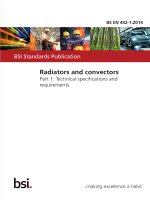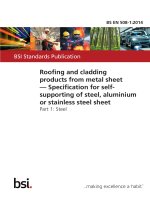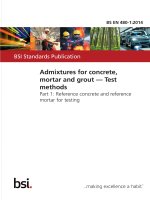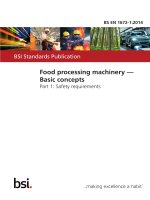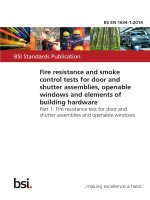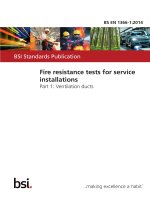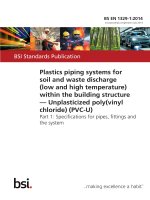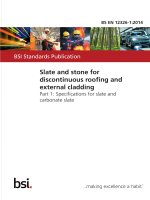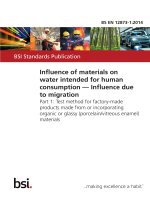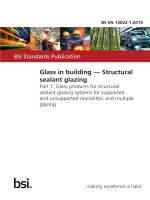Bsi bs en 12309 1 2014
Bạn đang xem bản rút gọn của tài liệu. Xem và tải ngay bản đầy đủ của tài liệu tại đây (1.16 MB, 34 trang )
BS EN 12309-1:2014
BSI Standards Publication
Gas-fired sorption appliances
for heating and/or cooling with
a net heat input not exceeding
70 kW
Part 1: Terms and definitions
BS EN 12309-1:2014
BRITISH STANDARD
National foreword
This British Standard is the UK implementation of EN
12309-1:2014.Together with BS EN 12309-2 it supersedes BS EN
12309-1:2000, which will be withdrawn upon publication of BS EN
12309-2. Together with BS EN 12309-3:2014, BS EN 12309-4:2014, BS
EN 12309-5:2014, BS EN 12309-6:2014 and BS EN 12309-7:2014, it
supersedes BS EN 12309-2:2000, which is withdrawn.
The UK participation in its preparation was entrusted to Technical
Committee GSE/37, Gas fired sorption and laundering appliances.
A list of organizations represented on this committee can be obtained
on request to its secretary.
This publication does not purport to include all the necessary provisions
of a contract. Users are responsible for its correct application.
© The British Standards Institution 2015.
Published by BSI Standards Limited 2015
ISBN 978 0 580 78695 2
ICS 27.080; 91.140.30
Compliance with a British Standard cannot confer immunity from
legal obligations.
This British Standard was published under the authority of the
Standards Policy and Strategy Committee on 31 January 2015.
Amendments/corrigenda issued since publication
Date
Text affected
EN 12309-1
EUROPEAN STANDARD
NORME EUROPÉENNE
EUROPÄISCHE NORM
December 2014
ICS 27.080; 91.140.30
Supersedes EN 12309-1:1999, EN 12309-2:2000
English Version
Gas-fired sorption appliances for heating and/or cooling with a
net heat input not exceeding 70 kW - Part 1: Terms and
definitions
Appareils à sorption fonctionnant au gaz pour le chauffage
et/ou le refroidissement de débit calorifique sur PCI inférieur
ou égal à 70 kW - Partie 1: Termes et définitions
Gasbefeuerte Sorptions-Geräte für Heizung und/oder
Kühlung mit einer Nennwärmebelastung nicht über 70 kW Teil 1: Begriffe
This European Standard was approved by CEN on 18 October 2014.
CEN members are bound to comply with the CEN/CENELEC Internal Regulations which stipulate the conditions for giving this European
Standard the status of a national standard without any alteration. Up-to-date lists and bibliographical references concerning such national
standards may be obtained on application to the CEN-CENELEC Management Centre or to any CEN member.
This European Standard exists in three official versions (English, French, German). A version in any other language made by translation
under the responsibility of a CEN member into its own language and notified to the CEN-CENELEC Management Centre has the same
status as the official versions.
CEN members are the national standards bodies of Austria, Belgium, Bulgaria, Croatia, Cyprus, Czech Republic, Denmark, Estonia,
Finland, Former Yugoslav Republic of Macedonia, France, Germany, Greece, Hungary, Iceland, Ireland, Italy, Latvia, Lithuania,
Luxembourg, Malta, Netherlands, Norway, Poland, Portugal, Romania, Slovakia, Slovenia, Spain, Sweden, Switzerland, Turkey and United
Kingdom.
EUROPEAN COMMITTEE FOR STANDARDIZATION
COMITÉ EUROPÉEN DE NORMALISATION
EUROPÄISCHES KOMITEE FÜR NORMUNG
CEN-CENELEC Management Centre: Avenue Marnix 17, B-1000 Brussels
© 2014 CEN
All rights of exploitation in any form and by any means reserved
worldwide for CEN national Members.
Ref. No. EN 12309-1:2014 E
BS EN 12309-1:2014
EN 12309-1:2014 (E)
Contents
Page
Foreword ..............................................................................................................................................................3
1
1.1
1.2
Scope ......................................................................................................................................................5
Scope of EN 12309 .................................................................................................................................5
Scope of this Part 1 of EN 12309 ..........................................................................................................5
2
Normative references ............................................................................................................................5
3
3.1
3.2
3.3
3.4
3.5
3.6
Terms and definitions ...........................................................................................................................6
Appliance and its constituents .............................................................................................................6
Combustion products circuit ............................................................................................................. 10
Adjusting, control and safety devices .............................................................................................. 10
Operation of the appliance ................................................................................................................ 12
Gases ................................................................................................................................................... 14
Conditions of operation, measurement and calculations .............................................................. 16
Bibliography ..................................................................................................................................................... 28
2
BS EN 12309-1:2014
EN 12309-1:2014 (E)
Foreword
This document (EN 12309-1:2014) has been prepared by Technical Committee CEN/TC 299 “Gas-fired
sorption appliances, indirect fired sorption appliances, gas-fired endothermic engine heat pumps and domestic
gas-fired washing and drying appliances”, the secretariat of which is held by UNI.
This European Standard shall be given the status of a national standard, either by publication of an identical
text or by endorsement, at the latest by June 2015, and conflicting national standards shall be withdrawn at
the latest by June 2015.
This document supersedes EN 12309-1:1999 and EN 12309-2:2000.
Attention is drawn to the possibility that some of the elements of this document may be the subject of patent
rights. CEN [and/or CENELEC] shall not be held responsible for identifying any or all such patent rights.
This standard comprises the following parts under the general title, Gas-fired sorption appliances for heating
and/or cooling with a net heat input not exceeding 70 kW:
—
Part 1: Terms and definitions;
—
Part 2: Safety;
—
Part 3: Test conditions;
—
Part 4: Test methods;
—
Part 5: Requirements;
—
Part 6: Calculation of seasonal performances;
—
Part 7: Specific provisions for hybrid appliances;
—
Part 8: Environmental aspects.
EN 12309-1 and EN 12309-2 supersede EN 12309-1:1999, whereas EN 12309-1, EN 12309-3, EN 12309-4,
EN 12309-5, EN 12309-6, and EN 12309-7 supersede EN 12309-2:2000.
EN 12309-1, EN 12309-2, EN 12309-3, EN 12309-4, EN 12309-5, EN 12309-6, and EN 12309-7 have been
prepared to address the essential requirements of the European Directive 2009/142/EC relating to appliances
burning gaseous fuels (see prEN 12309-2:2013, Annex ZA for safety aspects and EN 12309-5:2014,
Annex ZA for rational use of energy aspects).
These documents are linked to the Energy Related Products Directive (2009/125/EC) in terms of tests
conditions, tests methods and seasonal performances calculation methods under Mandate M/495 (see
EN 12309-3:2014, Annex ZA; EN 12309-4:2014, Annex ZA; EN 12309-6:2014, Annex ZA and EN 123097:2014, Annex ZA and prEN 12309-2:2013, Annex ZB and EN 12309-5:2014, Annex ZB).
These documents will be reviewed whenever new mandates could apply.
EN 12309-8 (“Environmental aspects”) deals with the incorporation of the Resolution BT 27/2008 regarding
CEN approach on addressing environmental issues in product and service standards.
Compared to EN 12309-1:1999, the following modifications have been made:
3
BS EN 12309-1:2014
EN 12309-1:2014 (E)
EN 12309-1:2014 gathers terms and definitions from all the other parts of EN 12309. Moreover, new terms
and definitions used in the other parts have been added and existing terms and definitions have been updated
consistently to the other parts of this standard.
According to the CEN-CENELEC Internal Regulations, the national standards organizations of the following
countries are bound to implement this European Standard: Austria, Belgium, Bulgaria, Croatia, Cyprus, Czech
Republic, Denmark, Estonia, Finland, Former Yugoslav Republic of Macedonia, France, Germany, Greece,
Hungary, Iceland, Ireland, Italy, Latvia, Lithuania, Luxembourg, Malta, Netherlands, Norway, Poland, Portugal,
Romania, Slovakia, Slovenia, Spain, Sweden, Switzerland, Turkey and the United Kingdom.
4
BS EN 12309-1:2014
EN 12309-1:2014 (E)
1
1.1
Scope
Scope of EN 12309
Appliances covered by this European Standard include one or a combination of the following:
—
gas-fired sorption chiller;
—
gas-fired sorption chiller/heater;
—
gas-fired sorption heat pump.
This European Standard applies to appliances designed to be used for space heating or cooling or
refrigeration with or without heat recovery.
This European Standard applies to appliances having flue gas systems of type B and C (according to
CEN/TR 1749) and to appliances designed for outdoor installations. EN 12309 does not apply to air
conditioners, it only applies to appliances having:
—
integral burners under the control of fully automatic burner control systems,
—
closed system refrigerant circuits in which the refrigerant does not come into direct contact with the water
or air to be cooled or heated,
—
mechanical means to assist transportation of the combustion air and/or the flue gas.
The above appliances can have one or more primary or secondary functions (i.e. heat recovery - see
definitions in EN 12309-1:2014).
In the case of packaged units (consisting of several parts), this standard applies only to those designed and
supplied as a complete package.
The appliances having their condenser cooled by air and by the evaporation of external additional water are
not covered by EN 12309.
Installations used for heating and/or cooling of industrial processes are not within the scope of EN 12309.
All the symbols given in this text should be used regardless of the language used.
1.2
Scope of this Part 1 of EN 12309
This part of this European Standard specifies the terms and definitions for gas-fired sorption appliances for
heating and/or cooling with a net heat input not exceeding 70 kW.
2
Normative references
Not applicable.
5
BS EN 12309-1:2014
EN 12309-1:2014 (E)
3
3.1
Terms and definitions
Appliance and its constituents
3.1.1
absorption
process in which molecules of the refrigerant are dissolved into a liquid
3.1.2
adsorption
process in which molecules of the refrigerant are held at the surface of a solid (possibly porous) structure
3.1.3
aeration adjuster
device enabling the air to be set at the desired value according to the supply conditions
3.1.4
air-conditioners
encased assembly or assemblies designed as an appliance to provide delivery of conditioned air to an
enclosed space (room for instance) or zone
Note 1 to entry:
The medium used for distribution of heating and/or cooling is exclusively air.
3.1.5
appliance
assembly of various parts according to the installation instructions, if the appliance is supplied to the market in
multiple parts
Note 1 to entry:
Accessories provided optionally are not to be included.
Note 2 to entry:
Appliance may be supplied to be marketed in one or more than one part.
3.1.6
bivalent appliance
encased assembly or assemblies designed and packaged which is made up of components that can be tested
separately
3.1.7
brine
liquid that has a freezing point depressed relative to water
3.1.8
chiller
encased assembly or assemblies designed as an appliance, whose primary function is delivery of cooling
only, and whose primary function is dependent on circulation of fluid (refrigerant and/or solution) within the
absorption, adsorption or refrigerant circuit(s)
3.1.9
chiller/heater
encased assembly or assemblies, whose primary function is delivery of cooling and/or heating and whose
primary function of cooling is dependent on circulation of fluid (refrigerant and/or solution) within the
absorption, adsorption or refrigerant circuit(s)
Note 1 to entry:
system.
6
The primary function of heating only uses directly or indirectly the energy delivered by the combustion
BS EN 12309-1:2014
EN 12309-1:2014 (E)
3.1.10
closed system
system in which the fluid within the refrigerant circuit (e.g. water, ammonia, etc.) providing heating or cooling
does not come into contact with the surrounding air or the heat transfer medium (e.g. water, brine, air)
3.1.11
condensing appliance
appliance in which, under normal operating conditions and at certain operating water temperatures, the water
vapour in the combustion products is partially condensed in order to make use of the latent heat of this water
vapour for heating and/or heat recovery purposes
3.1.12
ductless appliance
outdoor appliance which is not designed to be fitted with external ducts to transport air to, or products of
combustion away from, the appliance’s casing
3.1.13
gas circuit
part of the appliance that conveys or contains the gas between the appliance gas inlet connection and the
burner(s)
3.1.14
gas fired
appliance which mainly consume gas for implementation of the function or functions, the electrical power
consumption being dedicated to auxiliaries needed for operation
3.1.15
gas inlet connection
part of the appliance intended to be connected to the gas supply
3.1.16
gas rate adjuster
component allowing an authorized person to set the gas rate of the burner to a predetermined value according
to the supply conditions
Note 1 to entry:
Adjustment may be progressive (screw adjuster) or in discrete steps (by changing restrictors).
Note 2 to entry:
The adjusting screw of an adjustable pressure regulator is regarded as a rate adjuster.
3.1.17
heat pump
encased assembly or assemblies designed as an appliance whose primary function is delivery of heat and/or
cooling (the primary function is dependent on circulation of fluid (refrigerant and/or solution) within the
absorption, adsorption or refrigerant circuit(s))
3.1.18
heat recovery
recovery of heat rejected by the appliance whose primary control is in the cooling mode by means of an
additional heat exchanger (e.g. a chiller with an additional condenser or absorber)
7
BS EN 12309-1:2014
EN 12309-1:2014 (E)
3.1.19
heat transfer medium
any medium (e.g. air, water, brine, etc.) used for the transfer of heat to or from refrigerant-containing parts of
the appliance
Note 1 to entry:
The medium may be
–
the cooling medium circulating in the evaporator,
–
the cooling medium circulating in the condenser and/or absorber and/or flue gas heat exchanger,
–
the heat recovery medium circulating in the heat recovery heat exchanger.
3.1.20
hybrid appliance
encased assembly or assemblies utilizing at least two different technologies whose primary function is to
generate heat, including overall control system that selects, according to predefined parameters, which
technology (or combination thereof) satisfies the customers' requirements while minimizing energy costs,
consumption and/or carbon emissions
Note 1 to entry:
Hybrid appliances according to the scope of this standard are based on gas fired technologies.
3.1.21
ignition burner
burner whose flame is intended to ignite another burner
3.1.22
ignition device
any means (flame, electrical ignition device or other device) used to ignite the gas at the ignition burner or at
the main burner
Note 1 to entry:
This device can operate intermittently or permanently.
3.1.23
indoor heat exchanger
heat exchanger which is designed to transfer heat to the indoor part of the building or to the indoor hot water
supplies or to remove heat from these
Note 1 to entry:
In the case of heat pumps operating in cooling mode, this is the evaporator. In the case of heat pumps
operating in heating mode, this is the condenser.
3.1.24
injector
component that admits the gas into a burner
3.1.25
main burner
burner that is intended to assure the thermal function of the appliance and is generally called “the burner”
8
BS EN 12309-1:2014
EN 12309-1:2014 (E)
3.1.26
mechanical joint
means of assuring the soundness of an assembly of several (generally metallic) parts without the use of
liquids, pastes, tapes, etc.
Note 1 to entry:
The means are, for example:
–
metal to metal joints;
–
conical joints;
–
toroidal sealing rings (“O” rings);
−
flat joints.
3.1.27
monovalent appliance
encased assembly or assemblies whose primary and secondary functions are dependent on circulation of fluid
(refrigerant and/or solution) within the absorption, adsorption or refrigerant circuit(s)
3.1.28
outdoor heat exchanger
heat exchanger which is designed to remove heat from the outdoor ambient environment, or any other
available heat source, or to transfer heat to it
Note 1 to entry:
In the case of heat pumps operating in cooling mode, this is the condenser. In the case of heat pumps
operating in heating mode, this is the evaporator.
3.1.29
open system
system in which the fluid within the refrigerant circuit (e.g. water, etc.) providing heating or cooling comes into
direct contact with the heat transfer medium (e.g. water, air, etc.) which is to be heated or cooled
3.1.30
packaged unit
factory assembly of components of heat pump, chiller or chiller/heater fixed on a common mounting to form a
discrete unit
3.1.31
primary function
main purpose for which the sorption appliance is designed
Note 1 to entry:
heating function.
In the case of chiller, the main purpose is the cooling function; in the case of a heat pump this is the
Note 2 to entry:
Both the heating and cooling functions of the sorption appliance may be classed as primary functions
if they satisfy the rational use of energy requirements for those functions.
3.1.32
putting an adjuster or a control out of service
procedure by which a control (temperature, pressure, etc.) is put out of action and sealed in this position
3.1.33
restrictor
part with an orifice, which is placed in the gas circuit so as to create a pressure drop and thus reduce the gas
pressure at the burner to a predetermined value for a given supply pressure and rate
9
BS EN 12309-1:2014
EN 12309-1:2014 (E)
3.1.34
sealing an adjuster
procedure by which an adjuster is set so that changing the setting of the adjuster breaks the sealing material
and makes the interference with the adjuster apparent
Note 1 to entry:
A factory sealed adjuster is considered to be non-existent.
Note 2 to entry:
A regulator is considered to be non-existent if it has been factory sealed in the fully opened position.
3.1.35
secondary function
optional function of the sorption appliance, such as heating or cooling, which is not expected to satisfy the
rational use of energy requirements of a primary function
3.1.36
setting an adjuster
procedure by which an adjuster is immobilized in a position by some means (e.g. screw)
3.1.37
sorption
process that is absorption or adsorption
3.1.38
sorption appliance
generic word used to describe all the appliances covered by this standard
Note 1 to entry:
3.2
The medium used for distribution of heating and/or cooling is liquid.
Combustion products circuit
3.2.1
combustion chamber
enclosure inside which combustion of the air/gas mixture takes place
3.2.2
draught diverter
device placed in the combustion products circuit to reduce the influence of flue pull and prevent down draught
affecting on the burner performance and combustion
3.2.3
flue outlet
part of the appliance that connects with a flue to evacuate the products of combustion
3.2.4
flue terminal
device fitted at the end of the duct system that enables the discharge of flue gases and may, at the same time,
allow entry of combustion air
3.3
Adjusting, control and safety devices
3.3.1
adjustable pressure regulator
regulator provided with means for changing the outlet pressure setting
3.3.2
automatic burner control system
system comprising at least a programming unit and all the elements of a flame detector device
10
BS EN 12309-1:2014
EN 12309-1:2014 (E)
3.3.3
automatic shut-off valve
device that automatically opens, closes or varies the gas rate on a signal from the control circuit and/or the
safety circuit
3.3.4
control thermostat
device controlling the operation of the appliance by on/off, high/low or modulating control and enabling the
temperature to be kept automatically, within a given tolerance, at a predetermined value
3.3.5
fan delay control
control that starts and/or stops the air delivery fan when the temperature of the delivered air reaches a certain
predetermined value
3.3.6
flame detector device
device by which the presence of a flame is detected and signalled
3.3.7
flame signal
signal given by the flame detector device, normally when the flame sensor senses a flame
3.3.8
flame simulation
condition that occurs when the flame signal indicates the presence of a flame when in reality no flame is
present
3.3.9
flame supervision device
device that, in response to a signal from the flame detector, keeps the gas supply open and shuts it off in the
absence of the supervised flame
3.3.10
high/low control
automatic control that permits an appliance to operate either at the nominal heat input or at a fixed reduced
heat input
3.3.11
modulating control
automatic control by which the heat input of the appliance is adjusted continuously between the nominal heat
input and a minimum value
3.3.12
overheat control device
device that shuts off and locks out the gas supply before the appliance is damaged and/or before safety is put
into question, and that automatically resets
3.3.13
overheat cut-off device
device that shuts off and locks out the gas supply before the appliance is damaged and/or before safety is put
into question, and that requires manual intervention to restore the gas supply
11
BS EN 12309-1:2014
EN 12309-1:2014 (E)
3.3.14
pressure regulator
device that maintains the outlet pressure constant independent on the variations in inlet pressure and/or flow
rate within defined limits
Note 1 to entry:
The term “regulator” is used in this case for a volume regulator.
3.3.15
program
sequence of control operations determined by the programming unit involving switching on, starting up,
supervising and switching off the burner
3.3.16
programming unit
unit which reacts to signals from control and safety devices, gives control commands, controls the start-up
sequence, supervises the burner operation and causes controlled shut-down and, if necessary, safety shutdown and lock-out
Note 1 to entry:
The programming unit follows a predetermined sequence of actions and always operates in
conjunction with a flame detector device.
3.3.17
range rating device
component in the appliance intended to be used to adjust the heat input of the appliance, within a range of
heat inputs stated in the operating instructions, to suit the actual heat requirements of the installation
Note 1 to entry:
This adjustment may be progressive (e.g. by use of a screw adjuster) or in discrete steps (e.g. by
changing restrictors).
3.3.18
spillage monitoring system
system which contains a device that automatically shuts off the gas supply to the main burner, and perhaps
the ignition burner, when there is a release of combustion products from the appliance
3.3.19
temperature sensing element or sensor
component that detects the temperature of the environment to be supervised or controlled
3.4
Operation of the appliance
3.4.1
automatic burner system
burner system in which, when starting from the completely shut-down condition, the gas is ignited and the
flame is detected and proved without manual intervention
3.4.2
automatic recycling
process by which, following loss of flame signal during the running condition or accidental interruption of the
operation of the appliance, the gas supply is interrupted and the complete start sequence is automatically re
initiated
Note 1 to entry:
This process ends with the restoration of the running condition or, if there is no flame signal at the end
of the safety time, or if the cause of the accidental interruption has not disappeared, with volatile lock out or non-volatile
lock out.
12
BS EN 12309-1:2014
EN 12309-1:2014 (E)
3.4.3
controlled shut-down
process by which the power to the gas shut off valve(s) is removed immediately, e.g. as a result of the action
of a controlling function
3.4.4
extinction safety time
time interval between extinction of the supervised flame and the gas supply being shut off:
—
to the main burner;
—
and/or to the ignition burner
3.4.5
first safety time
interval between the instant the ignition burner gas valve, the start gas valve or main gas valve, as applicable,
being energized and the instant the ignition burner gas valve, start gas valve or main gas valve, as applicable,
being deenergized if the flame detector signals the absence of a flame at the end of this interval
3.4.6
flame stability
characteristic of flames that remain on the burner ports or in the flame reception zone intended by the
construction
3.4.7
flame lift
total or partial lifting of the base of the flame away from the burner port or the flame reception zone provided
by the design
Note 1 to entry:
Flame lift may cause the flame to blow out, i.e. extinction of the air gas mixture.
3.4.8
ignition interlock
part that prevents the operation of the igniter as long as the main gasway is open
3.4.9
ignition opening time
time interval between ignition of the supervised flame and the moment when the valve is held open
3.4.10
ignition safety time
time that elapses between the order to open and the order to close the gas supply to the burner in the event of
ignition
3.4.11
light-back
entry of a flame into the body of the burner
3.4.12
non-volatile lock-out
safety shut-down condition of the system, such that a restart is only accomplished by a manual reset of the
system and by no other means
3.4.13
re-start interlock
mechanism which prevents the re-opening of the gasway to the main burner or the main burner and the
ignition burner until the armature plate has separated from the magnetic element
13
BS EN 12309-1:2014
EN 12309-1:2014 (E)
3.4.14
safety shut-down
process which is effected immediately following the response of a safety limiter or sensor or the detection of a
fault in the burner control system and which puts the burner out of operation by immediately removing the
power to the gas shut-off valve(s) and the ignition device
3.4.15
second safety time
interval between the main gas valve being energized and the main gas valve being deenergized if the flame
detector signals the absence of a flame at the end of this interval
Note 1 to entry:
It occurs where there is a first safety time applicable to either an ignition burner or start gas flame only.
3.4.16
sooting
phenomenon appearing during incomplete combustion and characterized by deposits of soot on the surfaces
or parts in contact with the combustion products or with the flame
3.4.17
spark restoration
process by which, after disappearance of the flame signal in the running condition, the ignition device is
energized again without the gas supply having been totally interrupted ; this process ends with the restoration
of the running condition or, if there is no flame signal at the end of the safety time, with volatile or non-volatile
lock out
3.4.18
ignition flame
flame established at the ignition rate either at the main burner or at a separate ignition burner
3.4.19
volatile lock-out
safety shut down condition of the system, such that a restart is only accomplished either by the manual reset
of the system, or by an interruption of the electrical supply and its subsequent restoration
3.4.20
yellow tipping
yellowing of the tip of the blue cone of an aerated flame
3.5
Gases
3.5.1
calorific value
quantity of heat produced by combustion at a constant pressure equal to 1 013,25 mbar, of a unit volume or
mass of gas, the constituents of the combustible mixture being taken at reference conditions and the products
of combustion being brought to the same conditions
Note 1 to entry:
A distinction is made between
–
the gross calorific value Hs in which the water produced by combustion is assumed to be condensed;
—
the net calorific value Hi in which the water produced by combustion is assumed to be in the vapour state.
Note 2 to entry:
The calorific value is expressed
3
–
either in megajoules per cubic metre of dry gas at the reference conditions (MJ/m ),
–
or in megajoules per kilogram of dry gas (MJ/kg).
14
BS EN 12309-1:2014
EN 12309-1:2014 (E)
3.5.2
gas pressure
p
static pressure, relative to the atmospheric pressure, measured at right angles to the direction of flow of the
gas
3.5.3
limit gases
test gases representative of the extreme variations in the characteristics of the gases for which appliances
have been designed
3.5.4
limit pressures
pressures representative of the extreme variations in the appliance supply conditions
Note 1 to entry:
The maximum and minimum pressures are abbreviated pmax and pmin respectively.
3.5.5
normal pressure
pn
pressure under which the appliances operate in normal conditions, when they are supplied with the
corresponding reference gas
3.5.6
pressure couple
combination of two distinct gas distribution pressures applied by reason of the significant difference existing
between the Wobbe indices within a single family or group in which:
—
the higher pressure corresponds only to gases of low Wobbe index;
—
the lower pressure corresponds to gases of high Wobbe index
3.5.7
relative density
d
ratio of the masses of equal volumes of dry gas and dry air, under the same conditions of temperature and
pressure: 15 °C and 1 013,25 mbar
3.5.8
reference conditions
for calorific values: temperature conditions of 15 °C
-
for gas and air volumes: dry conditions, brought to 15 °C and to an absolute pressure of 1 013,25 mbar
3.5.9
reference gases
test gases with which appliances operate under nominal conditions when they are supplied at the
corresponding normal pressure
3.5.10
test gases
gases consisting of reference gases and limit gases, intended for the verification of the operational
characteristics of appliances using combustible gases
3.5.11
test pressures
gas pressures, consisting of normal and limit pressures, used to verify the operational characteristics of
appliances using combustible gases
15
BS EN 12309-1:2014
EN 12309-1:2014 (E)
3.5.12
Wobbe index
ratio of the calorific value of a gas per unit volume and the square root of its relative density under the same
reference conditions
Note 1 to entry:
The Wobbe index is said to be gross (Ws) or net (Wi) according to whether the calorific value used is
the gross or net calorific value.
Note 2 to entry:
The Wobbe index is expressed
3
–
either in megajoules per cubic metre of dry gas at the reference conditions (MJ/m ),
–
or in megajoules per kilogram of dry gas (MJ/kg).
3.6
Conditions of operation, measurement and calculations
3.6.1
active mode
mode corresponding to the hours with a cooling or heating load of the building and whereby the cooling or
heating function of the appliance is switched on
3.6.2
aperture area
A
aperture area of the applied solar collectors as an environmental heat source
Note 1 to entry:
2
The aperture area A is expressed in m .
3.6.3
application rating condition
rating condition which provides additional information on the performance of the appliance within its operating
range when applicable
3.6.4
auxiliary Energy Factor in cooling mode, declared capacity
AEFcDC
effective cooling declared capacity to electrical power input ratio
Note 1 to entry:
AEFcDC is expressed in kW/kW.
3.6.5
auxiliary Energy Factor in cooling mode, part load
AEFcPL
effective cooling part load capacity to electrical power input ratio
Note 1 to entry:
AEFcPL is expressed in kW/kW.
3.6.6
auxiliary Energy Factor in heating mode, declared capacity
AEFhDC
effective heating declared capacity to electrical power input ratio
Note 1 to entry:
16
AEFhDC is expressed in kW/kW.
BS EN 12309-1:2014
EN 12309-1:2014 (E)
3.6.7
auxiliary Energy Factor in heating mode, part load
AEFhPL
effective heating part load capacity to electrical power input ratio
Note 1 to entry:
AEFhPL is expressed in kW/kW.
3.6.8
available external static pressure difference
Δpe
positive pressure difference measured between the air (or water) outlet section and the air (or water) inlet
section of the unit, which is available for overcoming the pressure drop of any additional ducted air (or water)
circuit
3.6.9
internal static pressure difference
Δpi
negative pressure difference measured between the air (or water) outlet section and the air (or water) inlet
section of the unit, which corresponds to the total pressure drop of all components on the air (or water) side of
the unit
3.6.10
balance point temperature or heating limit temperature
TBP
outdoor temperature, below which the heating appliance starts to supply heat to the building
Note 1 to entry:
TBP is expressed in °C.
3.6.11
bin hours
hj
sum of all hours occurring in a year at a given outdoor temperature for a specific location
Note 1 to entry:
hj is expressed in hours.
3.6.12
bivalent temperature
Tbivalent
lowest outdoor temperature at which the heating load is equal to the appliance declared capacity
Note 1 to entry:
Tbivalent is expressed in °C.
3.6.13
capacity ratio
CR
cooling (or heating) part load or full load divided by the declared cooling (or heating) capacity of the appliance
at the same temperature conditions
Note 1 to entry:
CR is expressed in kW/kW.
3.6.14
cold condition
condition of the appliance required for some tests and obtained by allowing the unlit appliance to attain
thermal equilibrium at room temperature
17
BS EN 12309-1:2014
EN 12309-1:2014 (E)
3.6.15
cooling capacity
usable heat given off by the heat transfer medium to the refrigerant integrated over and divided by a defined
interval of time
3.6.16
cyclic operation
mode of operation leading to a cyclic shutdown of the burner due to the variation of the heating or cooling
demand
Note 1 to entry:
According to this definition, a transient operation is not considered as a cyclic operation.
Note 2 to entry:
defrost period.
A cyclic operation can include or exclude a defrost period. A non-cyclic operation can also include a
3.6.17
declared capacity
DC
full load (maximum) heating or cooling capacity that the appliance can deliver at any given temperature
condition declared
Note 1 to entry:
DC is expressed in kW.
3.6.18
defrost mode
state of the appliance in the heating mode where the operation is modified or reversed to defrost the outdoor
heat exchanger
3.6.19
defrost period
time for which the appliance is in the defrost mode
3.6.20
design heating fluid temperature
THF-d
heating fluid mean temperature corresponding to the design outdoor temperature
3.6.21
design inlet temperature
Tin-d
inlet temperature of the outdoor or indoor heat exchanger corresponding to the design outdoor temperature
3.6.22
design load for cooling
Pdesignc
cooling load of the building at the reference design conditions for cooling
Note 1 to entry:
Pdesignc is expressed in kW.
3.6.23
design load for heating
Pdesignh
heating load of the building at the reference design conditions for heating
Note 1 to entry:
18
Pdesignh is expressed in kW.
BS EN 12309-1:2014
EN 12309-1:2014 (E)
3.6.24
design supply temperature
Tout-d
outlet temperature of the indoor or outdoor heat exchanger corresponding to the design outdoor temperature
3.6.25
effective electrical power input
PE
electrical power input of the appliance within the defined interval of time including share of electrical power
input of the conveying devices (e.g. fans, pumps) for ensuring the transport of the heat transfer media inside
the appliance
Note 1 to entry:
PE is expressed in kW.
3.6.26
effective heating, cooling or heat recovery capacity
QEh, QEc, QEhr
heating, cooling or heat recovery capacity including correction capacity due to the pump(s)
Note 1 to entry:
QEh, QEc, QEhr are expressed in kW.
3.6.27
equivalent resistance
resistance to flow in millibar, measured at the outlet of the appliance, which is equivalent to that of the actual
flue/duct
3.6.28
full load
operation state providing maximum useful capacity under given conditions
3.6.29
efficiency of the external auxiliary gas-fired heating system
ηAux
efficiency, expressed in GCV, of the external auxiliary gas boiler
Note 1 to entry:
ηAux is expressed in kW/kW.
3.6.30
gas heat input
Qg
quantity of gas energy used within the defined interval of time corresponding to the gas volume or mass flow
rates, the gas calorific value to be used being the net or gross calorific value
Note 1 to entry:
Qg is expressed in kW.
3.6.31
gas utilization efficiency ratio in cooling mode, declared capacity
GUEcDC
effective cooling declared capacity to gas input ratio
Note 1 to entry:
Gas input is expressed in GCV; GUEcDC is expressed in kW/kW.
3.6.32
gas utilization efficiency ratio in cooling mode
GUEc
effective cooling capacity to gas input ratio
Note 1 to entry:
Gas input is expressed in GCV; GUEc is expressed in kW/kW.
19
BS EN 12309-1:2014
EN 12309-1:2014 (E)
3.6.33
gas utilization efficiency ratio in heating mode, declared capacity
GUEhDC
declared effective heating capacity to gas input ratio
Note 1 to entry:
Gas input is expressed in GCV; GUEhDC is expressed in kW/kW.
3.6.34
gas utilization efficiency ratio in heating mode
GUEh
declared effective heating capacity to gas input ratio
Note 1 to entry:
Gas input is expressed in GCV; GUEh is expressed in kW/kW.
3.6.35
ground heat source
GHS
borehole heat exchanger, which is mounted in the underground (beneath the surface of the earth) and has the
main function to deliver environmental heat to the evaporator of the appliance
3.6.36
heat recovery capacity
usable heat given off in the cooling mode from the appliance to the heat transfer medium integrated over and
divided by a defined interval of time
3.6.37
heating capacity
usable heat given off in the heating mode from the appliance to the heat transfer medium integrated over and
divided by a defined interval of time
Note 1 to entry:
appropriate.
If heat is removed from the indoor heat exchanger(s) for defrosting, it is taken into account as
3.6.38
heating fluid temperature
THF(Toutdoor)
heating fluid mean temperature corresponding to the outdoor temperature
3.6.39
heating power of the external auxiliary gas-fired heating system
PAux
heating power provided by the auxiliary gas boiler in order to cover the difference between building load and
declared capacity of the heat pump appliance
Note 1 to entry:
PAux is expressed in kW.
3.6.40
heating surface exponent
n
exponent of the relationship between the part load ratio and the ratio between the temperature gradient
between the heating fluid average temperature and the design room temperature at any given outdoor
temperature to the design temperature gradient
Note 1 to entry:
20
The heating surface exponent is determined experimentally.
BS EN 12309-1:2014
EN 12309-1:2014 (E)
3.6.41
hot condition
condition of the appliance required for some tests and obtained by heating to thermal equilibrium at the
nominal heat input specified
3.6.42
indoor installation
installation in an enclosed space protected from the direct or indirect action of wind and precipitation
3.6.43
indoor temperature
Tindoor
design indoor temperature
3.6.44
load
range of useful capacity from 0 to full load
Note 1 to entry:
The load is expressed in kW.
3.6.45
maximum Temperature Difference
ΔTmax
maximum Temperature Difference allowed across the indoor heat exchanger of the appliance operating in
heating mode
3.6.46
measured heating, cooling or heat recovery capacity
Qh, Qc, Qhr
heating, cooling or heat recovery capacity measured during the test
Note 1 to entry:
Qh, Qc, Qhr are expressed in kW.
3.6.47
minimal heat input
lowest heat input leading to a permanent operation of the burner
3.6.48
nominal
unique “standard rating condition” used for CE marking and selected within the standard rating conditions
Note 1 to entry:
Only one nominal condition is defined for each appliance.
3.6.49
nominal air flow rate
value of air flow rate declared at the standard air conditions
3.6.50
nominal heating, cooling or heat recovery capacity
QNh, QNc, QNhr
rated heating or cooling or heat recovery capacity corrected to “standard rating conditions” and at full load
Note 1 to entry:
These conditions included the reference gas at 15 °C and 1 013,25 mbar.
Note 2 to entry:
QNh, QNc, QNhr are expressed in kW.
21
BS EN 12309-1:2014
EN 12309-1:2014 (E)
3.6.51
nominal heating, cooling or heat recovery gas input
QgNh, QgNc, QgNhr
rated heating or cooling or heat recovery heat input at “standard rating conditions” and at full load
Note 1 to entry:
These conditions included the use of the reference gas at 15 °C and 1 013,25 mbar.
Note 2 to entry:
QgNh, QgNc, QgNhr are expressed in kW.
3.6.52
nominal voltage
voltage or range of voltages stated at which the appliance can operate normally
3.6.53
nominal water flow rate
water flow rate declared at the “standard rating conditions”
3.6.54
off mode
OFF
mode where the appliance is completely switched off and cannot be reactivated by either control device or
timer
Note 1 to entry:
Off mode means a condition in which the equipment is connected to the mains power source and is
not providing any function.
Note 2 to entry:
The following are also considered as off mode: conditions providing only an indication of off mode
condition; conditions providing only functionalities intended to ensure electromagnetic compatibility.
3.6.55
operating cycle with defrost
cycle consisting of a heating period and a defrost period, from defrost termination to defrost termination
3.6.56
outdoor installation
installation in an open space unprotected from the direct or indirect action of wind and precipitation
3.6.57
part load ratio
PLR
building load divided by the design load at a certain outdoor temperature
3.6.58
primary energy conversion factor for electricity
Primelec
primary energy factor for electricity, value based on ErP Directive (2009/125/EC) or by default equal to 2,5
3.6.59
primary energy conversion factor for gas
Primgas
primary energy factor for gas, value based on ErP Directive (2009/125/EC) or by default equal to 1 on GCV
3.6.60
primary energy ratio in cooling mode
PERc
ratio of the effective cooling capacity to the total primary energy input of appliance within the same interval of
time
22
BS EN 12309-1:2014
EN 12309-1:2014 (E)
3.6.61
primary energy ratio in heating mode
PERh
ratio of the effective heating capacity to the total primary energy input of appliance within the same interval of
time
3.6.62
operation limit temperature
TOL
lowest outdoor temperature at which the heat pump can still deliver heating capacity
Note 1 to entry:
TOL is expressed in °C.
3.6.63
rated
conditions selected for each appliance among the “standard conditions” and/or the application conditions, in
addition to nominal condition
Note 1 to entry:
Rated conditions can be multiple.
Note 2 to entry:
“Standard and application conditions” are defined in EN 12309–3:2014 and in EN 12309–7:2014.
3.6.64
rated air flow rate
air flow rate declared at given conditions different from “standard air conditions”
3.6.65
rated heating, cooling or heat recovery capacity
QRh, QRc, QRhr
heating, cooling or heat recovery capacity at full load declared at given conditions different from the one
selected as nominal heating, cooling or heat recovery capacity
Note 1 to entry:
QRh, QRc, QRhr are expressed in kW.
3.6.66
rated water flow rate
water flow rate declared at given conditions different from “standard rating conditions”
3.6.67
reduced capacity
capacity which is lower than the maximal capacity under the same given conditions
3.6.68
reference annual cooling demand
Qrefc
representative annual cooling demand which is used for the calculation of reference seasonal performance in
cooling mode
Note 1 to entry:
Qrefc is expressed in kWh.
3.6.69
reference annual heating demand
Qrefh
representative annual heating demand which is used for the calculation of reference seasonal performance in
heating mode
Note 1 to entry:
Qrefh is expressed in kWh.
23
